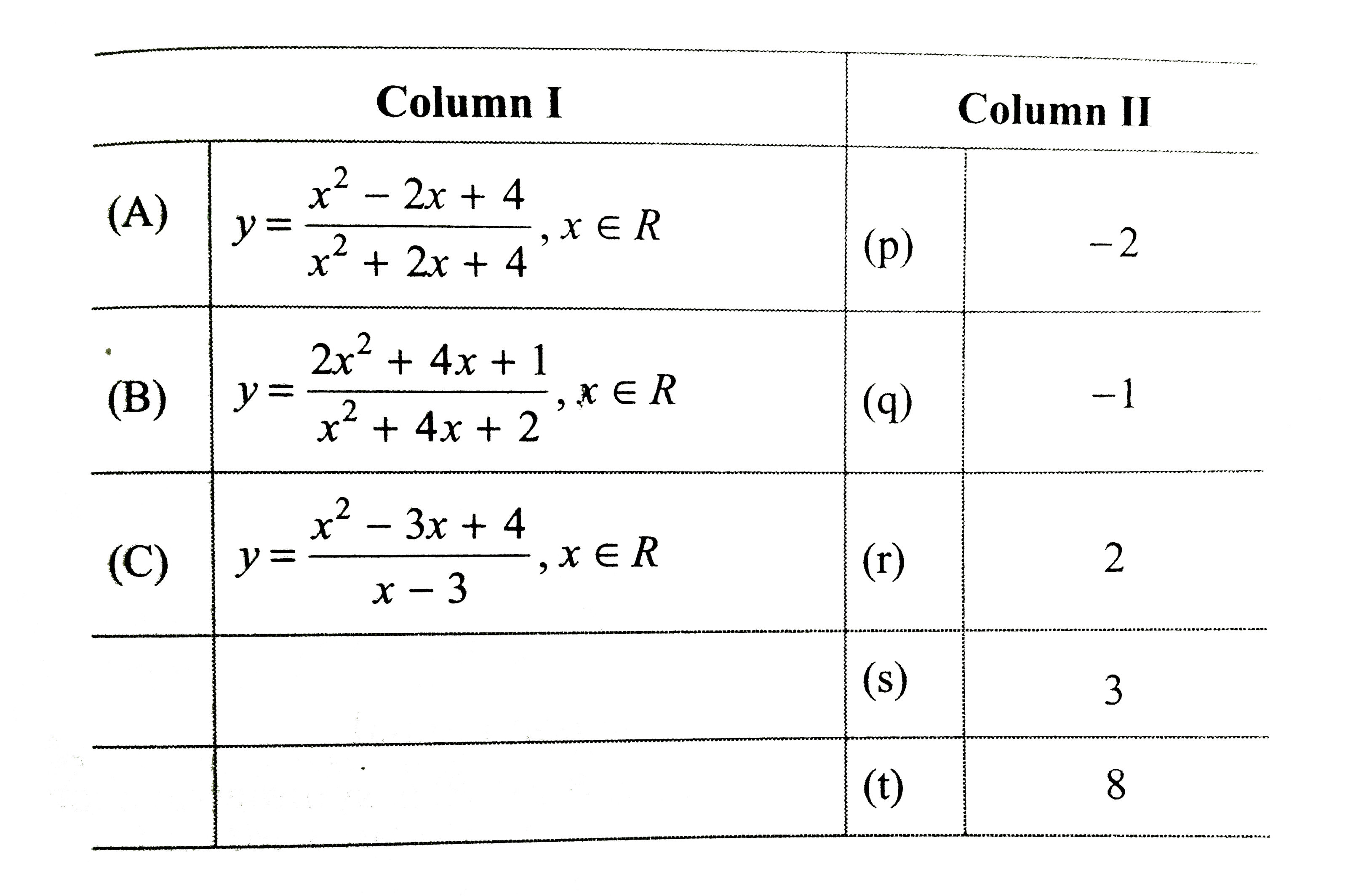If ax2+bx+c=0 have two distinct roots lying int eh interval (0,1),a,b,c εN The least value of b is
5
6
7
8
The correct Answer is:A
To solve the problem, we need to find the least value of b for the quadratic equation ax2+bx+c=0 such that it has two distinct roots lying in the interval (0,1), where a,b,c∈N.
Step 1: Conditions for Roots
For the quadratic equation to have two distinct roots in the interval (0,1), the following conditions must be satisfied:
1. f(0)>0
2. f(1)>0
3. The discriminant D=b2−4ac>0
Step 2: Evaluate f(0) and f(1)
- f(0)=c>0 (since c∈N)
- f(1)=a+b+c>0
Since a,b,c are natural numbers, both conditions are satisfied.
Step 3: Expressing the Roots
Let the roots of the equation be α and β. Since both roots lie in the interval (0,1), we can express the roots as:
- α+β=−ba
- αβ=ca
Step 4: Conditions from the Roots
From the conditions of the roots lying in (0,1):
- 0<α<1
- 0<β<1
This implies:
- 0<α+β<2
- 0<αβ<1
Step 5: Using AM-GM Inequality
Using the AM-GM inequality:
α+β+(1−α)+(1−β)4>√(4)αβ(1−α)(1−β)
This simplifies to:
24=12>√(4)αβ(1−α)(1−β)
Step 6: Finding the Minimum Value of b
From the discriminant condition:
b2>4ac
To minimize b, we can set a=5 and c=1 (the smallest natural numbers satisfying the conditions):
b2>20⟹b>√20≈4.47
Thus, the smallest integer b can take is 5.
Conclusion
The least value of b such that the quadratic equation ax2+bx+c=0 has two distinct roots in the interval (0,1) is:
5
For the quadratic equation to have two distinct roots in the interval (0,1), the following conditions must be satisfied:
1. f(0)>0
2. f(1)>0
3. The discriminant D=b2−4ac>0
- f(0)=c>0 (since c∈N)
- f(1)=a+b+c>0
Let the roots of the equation be α and β. Since both roots lie in the interval (0,1), we can express the roots as:
- α+β=−ba
- αβ=ca
From the conditions of the roots lying in (0,1):
- 0<α<1
- 0<β<1
- 0<α+β<2
- 0<αβ<1
Using the AM-GM inequality:
α+β+(1−α)+(1−β)4>√(4)αβ(1−α)(1−β)
This simplifies to:
24=12>√(4)αβ(1−α)(1−β)
From the discriminant condition:
b2>4ac
To minimize b, we can set a=5 and c=1 (the smallest natural numbers satisfying the conditions):
b2>20⟹b>√20≈4.47
Thus, the smallest integer b can take is 5.
The least value of b such that the quadratic equation ax2+bx+c=0 has two distinct roots in the interval (0,1) is:
5
Topper's Solved these Questions
- THEORY OF EQUATIONSBOOK - ARIHANT MATHS ENGLISHCHAPTER - THEORY OF EQUATIONSEXERCISE - Exercise (Single Integer Answer Type Questions)
10 Videos
- THEORY OF EQUATIONSBOOK - ARIHANT MATHS ENGLISHCHAPTER - THEORY OF EQUATIONSEXERCISE - Exercise (Matching Type Questions)
2 Videos
- THEORY OF EQUATIONSBOOK - ARIHANT MATHS ENGLISHCHAPTER - THEORY OF EQUATIONSEXERCISE - Exercise (More Than One Correct Option Type Questions)
15 Videos
- THE STRAIGHT LINESBOOK - ARIHANT MATHS ENGLISHCHAPTER - THE STRAIGHT LINESEXERCISE - Exercise (Questions Asked In Previous 13 Years Exam)
17 Videos
- THREE DIMENSIONAL COORDINATE SYSTEMBOOK - ARIHANT MATHS ENGLISHCHAPTER - THREE DIMENSIONAL COORDINATE SYSTEMEXERCISE - Three Dimensional Coordinate System Exercise 12 : Question Asked in Previous Years Exam
2 Videos
Similar Questions
The sum of all the real roots of the equation |x−2|2+|x−2|−2=0 is
View SolutionColumn I contains rational algebraic expressions and Column II contains possible integers which lie in their ragne. Match the entries of Column I with one or more entries of the elements of Column II.

View SolutionIf 0<a<b<c and the roots α,β of the equation ax2+bx+c=0 are non-real complex numbers, then
View SolutionThe line parallel to the x-axis and passing through the intersection of the lines ax+2by+3b=0 and bx−2y−3a=0 , where (a,b)≠(0,0) , is above the x-axis at a distance of 3/2 units from it above the x-axis at a distance of 2/3 units from it below the x-axis at a distance of 3/2 units from it below the x-axis at a distance of 2/3 units from it
View SolutionConsider the line L1:x−12=y−1=z+31,L2:x−41=y+31=z+32 find the angle between them.
View SolutionIf ax2−bx+c=0 have two distinct roots lying in the interval (0,1);a,b,∈N, then the least value of a , is
View SolutionIf a+b+2c=0,c≠0, then equation ax2+bx+c=0 has (A) at least one root in (0,1) (B) at least one root in (0,2) (C) at least on root in (-1,1) (D) none of these
View SolutionIf ax2+bx+10=0 does not have two distinct real roots, then the least value of 5a + b, is
View SolutionConsider the quadrationax2−bx+c=0,a,b,c∈N which has two distinct real roots belonging to the interval (1,2).
The least value of a is
View SolutionConsider the quadrationax2−bx+c=0,a,b,c∈N which has two distinct real roots belonging to the interval (1,2).
The least value of b is
View SolutionConsider the quadrationax2−bx+c=0,a,b,c∈N which has two distinct real roots belonging to the interval (1,2).
The least value of c is
View SolutionIf ax2−bx+c=0 have two distinct roots lying int eh interval (0,1),a,b,ceπslonN The least value of log5abc is
View SolutionConsider the quadrationax2−bx+c=0,a,b,c∈N which has two distinct real roots belonging to the interval (1,2).
The least value of b is
View SolutionIf ax2−bx+c=0 have two distinct roots lying in the interval (0,1);a,b,∈N, then the least value of a , is
View SolutionIf ax2−bx+c=0 have two distinct roots lying in the interval (0,1),a,b,cEψlonN The least value of log5abc is
View SolutionIfax2−bx+c=0 has two distinct roots lying in the interval (0,1),a,b,c∈N. Then
View Solution

